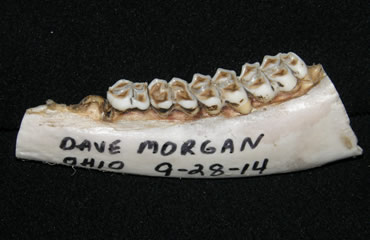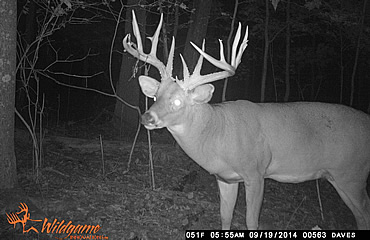And you think a 4- or 5-year-old buck is a challenge!
Dave Morgan of Richmond, Kentucky, played cat and mouse with an Ohio buck for four years before hearing his bowstring hum while looking at it.
He collected hundreds of trail camera photographs of the brute, but the elusive deer wasn’t keen on moving during the day or taking the same trail twice. The ancient whitetail even disappeared for long stretches, like during much of the summer of 2014, which forced Dave to consider harassing other deer.
He really wanted the nearly 200-incher, however.
“When you mention Ohio, most people think of flat land, but the terrain changes in Pike County,” Dave says. “The area we hunt has some pretty rugged mountains with a good mix of cropland and timber. All the ingredients are there to produce some trophy-sized animals.
“I’m lucky to have access to a farm owned by family members that covers about 2,000 acres. Several of my kinfolk hunt,” he continued. “I’ve been hunting there six or seven years, mostly with a bow. I even bowhunt through gun season.
“If I pick up anything else, it might be a muzzleloader for the late season,” he added.
The family farm is home to a lot of whitetails.
“At any given time, we try to keep track of about 30 to 40 bucks,” Dave said. “Not all of those are shooters, of course. We try to pick out specific features that allow us to identify individual deer and keep up with their growth until we feel they’re big enough to go after.”
In 2010, Dave began studying a beefy buck that had a boxy looking mainframe. He guessed it was about 3 1/2 to 4 1/2 years old, big enough to be considered a shooter in another year.
“We had several photos of that deer in 2010,” he said, “but 2011 was the first year we targeted it. It was also the first time I had that buck in close to my stand.
“It was mid-November, a couple of days before gun season. I was in a stand that I had placed at the edge of a deep ravine between two mountains. I could actually look down into the thick timber on the opposite hillside.
“I spotted movement at 200 yards, across the ravine,” he continued. “It was a giant buck.”
To get the deer’s attention, Dave blew his grunt call loudly in order to be heard over the wind.
“The buck looked my way several times, so I knew it heard the call,” he said. “But the deer just lowered its head and continued feeding along through the brush and briars. It eventually dropped down into the ravine.”
The encounter lasted 20 minutes.
 “I called a friend and told him what I’d seen, and we talked for a while. When the conversation was over, I put my phone away, took out my call and grunted a few more times,” Dave said.
“I called a friend and told him what I’d seen, and we talked for a while. When the conversation was over, I put my phone away, took out my call and grunted a few more times,” Dave said.
“All of a sudden, a 130- to 140-class buck came into view. It was skirting my stand, looking for the sound. I got ready and was going to shoot it, but it passed by at about 35 or 40 yards and never gave me a chance.
“After I was sure it wasn’t coming back, I texted my friend and said, ‘You’re not going to believe what just happened!’ Before I could continue, the big deer that had been 200 yards across from me reappeared, and it was coming my way,” he continued. “I texted, ‘Gotta go. Big one’s coming.’”
The buck was following an old haul road out of the ravine. As soon as Dave put away his phone, he stood and got his bow ready.
The big buck closed the gap quickly and stopped for three or four minutes when it was 20 yards from Dave, who couldn’t draw because the deer was facing him.
When the deer continued walking and veered to circle Dave’s birch tree, limbs obscured a shot.
“When I tried to reposition, it sensed something was wrong and bolted,” he said. “That was the last time I saw it from a stand until 2014.
“The buck was seen twice in 2012, once by another bowhunter in October and a second time during the youth season,” Dave said. “It was still showing up on camera, but was really hard to see in person.
“In 2013, we were getting hundreds of photos of the deer, and it was still growing. By then, its trophy potential was obvious, and it was probably our best buck on the farm,” he continued. “I had it patterned real well on cameras for a while, but something changed, and it disappeared again.”
Dave later learned that some guys had been moving around a lot on a neighboring farm, which the big buck also frequented. He chalked the deer’s disappearance up to their pressuring it.
Dave started running his cameras early in 2014. He knew the big buck had survived the ’13 season because family members had seen it before it shed its antlers.
“We had absolutely zero pictures of him that summer,” he said. “But in August, I got one single photo.
“It had grown several non-typical stickers and was bigger than ever,” he added.
Dave wanted to believe the deer had returned to its early-season haunt, that it might finally be patternable, but he was wrong. When he checked his cameras two weeks later, there wasn’t a single photo of the buck.
He couldn’t understand why the whitetail would show up one time, and then disappear.
“I started making plans to pattern and hunt another buck,” he admitted.
“In mid-September, about two weeks before the bow season opener, I was leaving the farm at dusk and saw the big buck. It was standing 30 yards from the edge of the road at the base of the hill where I was planning to hunt,” Dave said.
“It still had loose velvet hanging from its rack.
“I already had a mineral lick in place, so I went back and put some corn in the spot. I left it alone for two weeks after that, until I was ready to hunt,” he said.
The Friday before the Sept. 27 opener, Dave made some final checks of his stand sites and pulled cards from about a dozen cameras.
“The big non-typical with the stickers was on camera every day for the past two weeks in the area I had prepared to hunt,” he said. “By the time I wrote down all the times from the different cameras, I had a pretty good idea of where it was bedding and where to hunt.
“Opening day, I told the other guys ‘This deer can’t be hunted in the mornings. If I bump it going in, I’ll never see it again.’
“So that morning, I stayed down low just to observe. I discovered several scrapes,” he said. “That evening, I had to help a friend get a UTV unstuck, and by the time we finished and I got back and showered and ready to hunt, it was already 5:00.
“I figured the big deer wouldn’t move down off the mountain until late afternoon because it was so hot. I got to my tree, tied my bow to a pull rope and started climbing.
“That’s when I heard crashing above me. Something was coming off the mountain in a hurry. I said to myself ‘Please, Lord, don’t let that be the buck.‘”
It was indeed.
“I just hugged the tree, kept still and thought This is NOT happening. I should have stayed in camp,” he said.
 Dave was pinned. All he could do was remain still and hope the buck wouldn’t smell him.
Dave was pinned. All he could do was remain still and hope the buck wouldn’t smell him.
When the deer was gone, Dave pulled up his bow and kept pressing his mental replay button. Soon, two does came along and immediately winded him.
“After studying wind currents for a while, I decided to move my stand on the next hunt,” he said.
Dave slept in the following morning. He went out about 2 p.m., moved his stand about 30 yards and climbed 25 feet up a tree. It was 80 to 85 degrees.
“I took extra clothes,” he said. “I changed out of the sweaty ones and sprayed down with scent-killer. Afterward, I pulled out my card reader to look at the activity from the previous day.
“The buck had come back up the hill about 10 p.m., following the same trail it had taken downhill. So I was sure I hadn’t spooked it the previous afternoon,” he added.
“By evening, the wind died, and all I had to deal with was thermals,” Dave continued. “About 5:15, a doe came in and fed for about 15 or 20 minutes in the corn I had scattered. She wound up bolting. I checked the wind with my scent snuffer, but it was calm.”
At 6:00, Dave looked down the hollow and saw the rack of an approaching deer. He was pretty sure it was the big buck.
“When it turned its head, I saw the brow tines and knew it was the big one,” he said. “It came slowly walking toward me, right to the mineral lick at 25 yards, and turned broadside. There was some broadleaf underbrush in the way.
“I tried to stay calm, telling myself ‘Take your time; he’s not going to wind you.’
“The buck turned its attention to the corn and started inching along, slowly nibbling at the kernels. It moved about 3 yards closer.
“When its body cleared the brush and its head went behind a bush, I drew and anchored. The area just behind the front leg was clear, so I put the pin on that spot and drilled it,” he said.
The buck ran for about 30 yards, stopped and looked back. And then it disappeared over the ridge. A bit later, Dave heard a crashing sound.
“After waiting about 30 minutes, I got down and walked over to the edge,” he said. “I looked down, but I didn’t see anything until I slid down over the bank just a bit.”
Hunter: Dave Morgan
BTR Score: 196 4/8
View BTR Scoresheet
This article was published in the February 2016 edition of Rack Magazine. Subscribe today to have Rack Magazine delivered to your home.
Read Recent RACK Articles: • Day No. 6: And on the seventh day, he rested and looked at the strange deer he’d shot.
• The 21st Sit: They say too much pressure can ruin a stand. Notice they didn’t say “always.”
• Second Chance: Note to Self - A stagger doesn’t always precede a blood trail.